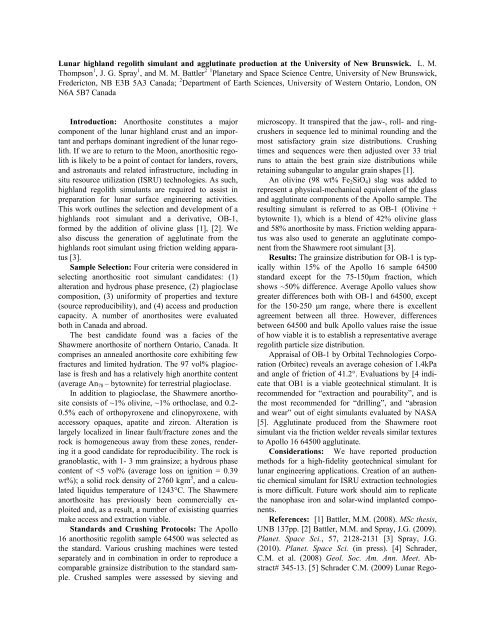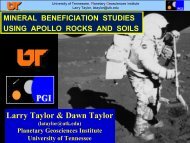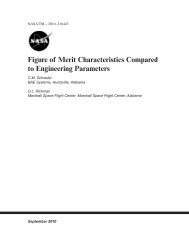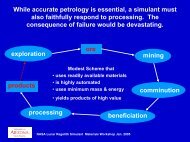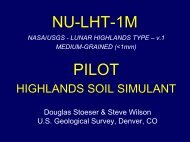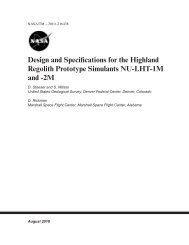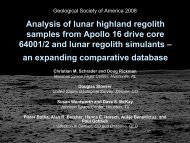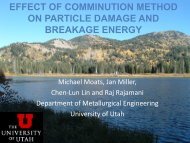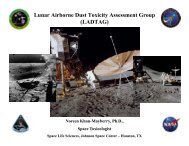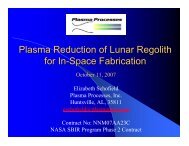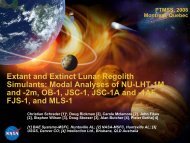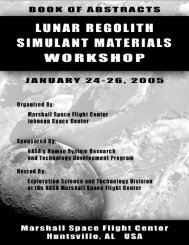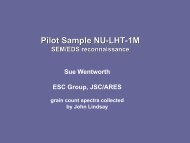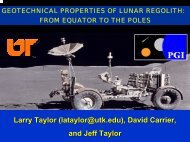Abstract - In Situ Resource Utilization (ISRU) - Nasa
Abstract - In Situ Resource Utilization (ISRU) - Nasa
Abstract - In Situ Resource Utilization (ISRU) - Nasa
You also want an ePaper? Increase the reach of your titles
YUMPU automatically turns print PDFs into web optimized ePapers that Google loves.
Lunar highland regolith simulant and agglutinate production at the University of New Brunswick. L. M.<br />
Thompson 1 , J. G. Spray 1 , and M. M. Battler 2 1 Planetary and Space Science Centre, University of New Brunswick,<br />
Fredericton, NB E3B 5A3 Canada; 2 Department of Earth Sciences, University of Western Ontario, London, ON<br />
N6A 5B7 Canada<br />
<strong>In</strong>troduction: Anorthosite constitutes a major<br />
component of the lunar highland crust and an important<br />
and perhaps dominant ingredient of the lunar regolith.<br />
If we are to return to the Moon, anorthositic regolith<br />
is likely to be a point of contact for landers, rovers,<br />
and astronauts and related infrastructure, including in<br />
situ resource utilization (<strong>ISRU</strong>) technologies. As such,<br />
highland regolith simulants are required to assist in<br />
preparation for lunar surface engineering activities.<br />
This work outlines the selection and development of a<br />
highlands root simulant and a derivative, OB-1,<br />
formed by the addition of olivine glass [1], [2]. We<br />
also discuss the generation of agglutinate from the<br />
highlands root simulant using friction welding apparatus<br />
[3].<br />
Sample Selection: Four criteria were considered in<br />
selecting anorthositic root simulant candidates: (1)<br />
alteration and hydrous phase presence, (2) plagioclase<br />
composition, (3) uniformity of properties and texture<br />
(source reproducibility), and (4) access and production<br />
capacity. A number of anorthosites were evaluated<br />
both in Canada and abroad.<br />
The best candidate found was a facies of the<br />
Shawmere anorthosite of northern Ontario, Canada. It<br />
comprises an annealed anorthosite core exhibiting few<br />
fractures and limited hydration. The 97 vol% plagioclase<br />
is fresh and has a relatively high anorthite content<br />
(average An 78 – bytownite) for terrestrial plagioclase.<br />
<strong>In</strong> addition to plagioclase, the Shawmere anorthosite<br />
consists of ~1% olivine, ~1% orthoclase, and 0.2-<br />
0.5% each of orthopyroxene and clinopyroxene, with<br />
accessory opaques, apatite and zircon. Alteration is<br />
largely localized in linear fault/fracture zones and the<br />
rock is homogeneous away from these zones, rendering<br />
it a good candidate for reproducibility. The rock is<br />
granoblastic, with 1- 3 mm grainsize; a hydrous phase<br />
content of
lith Simulant Workshop – March 17-20. Marshall<br />
Space Flight Center, Huntsville, Alabama. <strong>Abstract</strong>.


